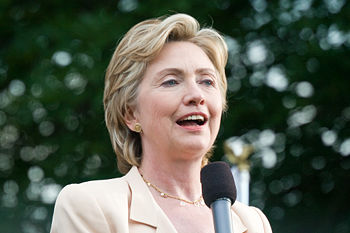Hillary Clinton
Hillary Clinton (born Hillary Diane Rodham, and known from 1975 to 2006 as Hillary Rodham Clinton), Democrat of New York, is the first woman to be a leading candidate for President. She served as First Lady when her husband Bill Clinton was president (1993-2001). A Democrat, in 2000 she was elected Senator from New York, and reelected in 2006. Her most controversial vote came in October 2002 when she backed President George W. Bush in endorsing an invasion of Iraq. In 2007 she led all the polls as first choice of Democrats for the 2008 presidential nomination, with especially strong support from women. In 2007 she raised $100 million for her campaign. Her leading opponent is Senator Barack Obama, who is running even with her in the Iowa caucuses (Jan. 3) and New Hampshire primary (Jan 8.)
For daily update on the polls see [3]
see 2008 United States presidential election
Early Career
She was born October 26, 1947, in Chicago in a middle class family; her father Hugh Rodham operated a small business. He was born into a coal mining family in Pennsylvania, graduated from Penn State University, and was known as a martinet. She grew up in Park Ridge, an upscale suburb of Chicago. Hillary Rodham, an active Methodist, attended Wellesley College, an elite woman's college near Boston. Starting as a Republican activist she became a liberal by her senior year. She graduated in 1969 with an antiwar speech that gained national attention. She attended Yale Law School (JD 1973), where she met Bill Clinton. As a staff attorney for the Children's Defense Fund, she specialized in children's advocacy law. She married Bill on October 11, 1975; daughter Chelsea was born in 1980. As her husband built a political career in Arkansas as governor, she was a partner in the locally prestigious Rose Law Firm, 1976-1992. Nationally she continued her legal advocacy for children and chaired the American Bar Association's Commission on Women in the Profession, which played a pioneering role in raising awareness of issues like sexual harassment and equal pay.
First Lady
Popularity
Cohen (2000) and Burden and Mughan (1999) examine the trends in public opinion polls measuring public favorability toward Hillary Clinton from 1993 to 1999. The data indicate that, while first ladies may bring policymaking and other types of advice to presidents, the institutional development of the first lady's office can best be understood in the context of presidential public relations. However, the data also reveal that, while related, presidential job approval and presidential favorability are far from identical and that favorability between the president and first lady is closer in meaning to poll respondents than presidential job approval is to first lady favorability. Presidential governing strategies cannot always be constructed on the idea of shifting public attention from the president to the First Lady and back again as the public fortunes of one decline while the other's rise.
Templin (1999) uses cartoon images of Clinton during 1992-96 to suggest a backlash against the professional woman. She cites cartoonists' obsession with Hillary, the continual use of clichés and stereotypes, and the overt sexism of the images and symbols used to depict her. Because cartoonists see Hillary violating gender norms, cartoon images of her tend to fall into the following categories: gender reversals (with Hillary wearing the pants and making the decisions), Hillary as radical feminist (the failed woman), as emasculator (depicted as a vicious shark), domestic imagery, woman as body (the ice maiden), the public woman (the tourist shouts, "Look! It's Hillary's husband!"), cherchez la femme, and the wife the husband wants to get rid of. The work of Susan Faludi on the 1980s backlash against women in positions of power, Judith Butler on gender, Germain Greer on the historical role of the first lady, and John Fiske on discourse and media events is useful in analyzing cartoonists' stances toward Hillary Clinton.
Health Care reform
Gottschalk (2000) and Martin (2000) argue that the reform failed because of the close relationships among big business, big labor, antitax groups, social conservatives, the health care industry, and other disparate groups intent on maintaining the status quo in one of the largest and most costly sectors of the American economy.
However, Wekkin (2005) argues that the 1993-94 health care reform proposals sponsored by President Clinton and drafted by Hillary Clinton were rejected because they were inherently flawed, not, as the President argued, because of a lack of effective marketing to Congress and the American public.
Scandals and impeachment
Senate years
Presidential campaign
See 2008 United States presidential election
In terms of campaign funding, the contenders in the two parties will spend some $2 billion to get the nomination. Clinton has been a highly successful fundraiser. For calendar years 2001 through 2006 her total receipts were $51.6 million, with spending of $40.8 miillion.[1] Clinton's best financed opponent is Barack Obama, trailed by John Edwards
Frank Luntz, the doyen of American campaign pollsters, observed in early December, 2007,
- "Among Democrats, Obama has the momentum, but Clinton has the organisation. Obama has been drawing the crowds and creating the buzz, but he has to turn curiosity into votes. But Clinton has one of the most formidable political organisations ever assembled. They play with broad shoulders and sharp elbows. They take no prisoners and accept no criticism. It's going to be quite a battle."[2]
